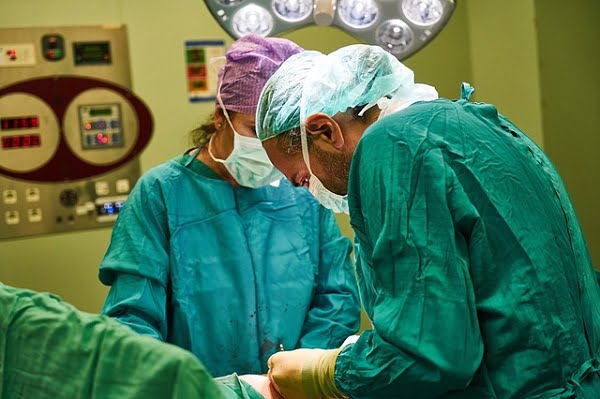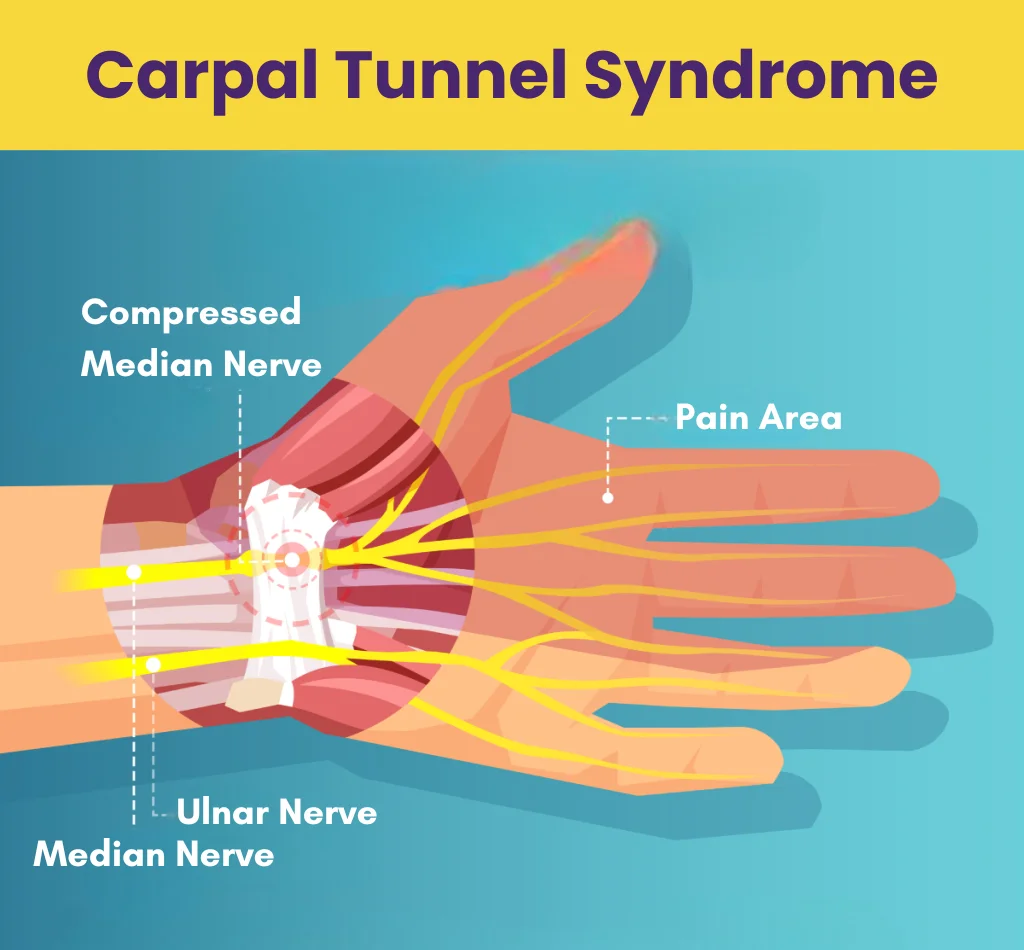
Is Surgery Necessary for Carpal Tunnel Syndrome? When Do You Need Carpal Tunnel Surgery?
Carpal tunnel syndrome is caused by compression of your median nerve which is responsible for feelings sensation in your thumb and all your fingers except your pinky. The median nerve passes through a narrow path at your wrist known as carpal tunnel which is made of bone and ligament. Due to irritation and swelling, the tunnel gets squeezed and pinches your median nerve. This, in turn, causes your symptoms of carpal tunnel syndrome.
Non-surgical treatments of carpal tunnel syndrome such as wrist braces and corticosteroids can help, but in more severe cases, you may need surgery. The surgical process is known as carpal tunnel release surgery and it is not suitable for everyone. Your doctor will review your case and recommend you options accordingly.
Longstanding compression of your median nerve in carpal tunnel can weaken the muscles of your hands and wrists. If symptoms go on for too long, your condition will keep getting worse. If you are experiencing a worsening situation, your doctor might suggest carpal tunnel release surgery for you.
More: Carpal Tunnel Syndrome (CTS): Causes, Symptoms, Diagnosis, Treatment
More: Carpal Tunnel Pain: What Relieves Carpal Tunnel Pain?
Is the Carpal Tunnel Surgery Painful? Can You Be Put to Sleep for Carpal Tunnel Surgery? Are You Awake for Carpal Tunnel Surgery?
Most of the cases of carpal tunnel surgery are done on an outpatient basis and it’s not painful. The surgery is performed either under general anaesthesia, which puts you to sleep, or under local anaesthesia, which numbs just your hand and arm.
You might also be given a light sedative through an intravenous (IV) line inserted into a vein in your arm for its sleep inducing effect.
What Is the Success Rate of the Carpal Tunnel Surgery?
Carpal tunnel surgery done to alleviate the symptoms can be successful but it’s not a cure for carpal tunnel syndrome. The success rate of surgery depends on the definition of “success” and the metrics applied for the assessment of the surgery either in terms of symptomatic relief or patient satisfaction. For example, up to 90% success is reported with respect to alleviation of symptoms, while in terms of patient satisfaction, the success rate falls to 50%. However, there is a 90% success rate with which people return to their work after the surgery.
What Kind of Surgery Is Done for Carpal Tunnel Syndrome? What Is Bilateral Carpal Tunnel Release Surgery?

There are two types of surgery which are used for releasing the median nerve in the carpal tunnel area of your wrist which includes:
- Open carpal tunnel release surgery
- Endoscopic carpal tunnel release surgery
In both the surgical options, your doctor cuts the transverse carpal ligament around the carpal tunnel to cut off the pressure on median nerve and relieve your symptoms. Surgery makes more room for your median nerve to pass through the carpal tunnel of your wrist however ligaments come together after the surgery.
Recently, carpal tunnel laser surgery is being talked and discussed by many but the real scenario is that this is a misnomer. It is almost impossible at least till now to sever transverse carpal ligament with a laser. However, in practice, what is done to treat carpal tunnel syndrome is to use a low level laser surgery to help stimulate proper blood circulation to disperse swelling.
When you are opting surgery for both of your hands, either consecutively or simultaneously, it is known as bilateral carpal tunnel surgery.
More: Problems after Carpal Tunnel Surgery: Pain And Numbness After Carpal Tunnel Surgery
More: Exercises to Relieve Carpal Tunnel Syndrome Pain
What Is Open Carpal Tunnel Release Surgery?
Open carpal tunnel release surgery is the traditional way of performing surgery to help treat pain and sensation loss from carpal tunnel syndrome by cutting off the pressure on the median nerve. It involves making a one- to- two-inch incision in the wrist which may vary depending on the patient.
This technique provides the surgeon a direct approach to see and cut the transverse carpal ligament resulting in immediate release of pressure from the median nerve. The incision is then closed with the help of sutures and stitches.
You will be able to leave the hospital on the same day of the procedure since the procedure is usually performed on an outpatient basis. After the passage of a defined healing period, your doctor may recommend hand rehabilitation therapy which is necessary in the process of rebuilding strength in your wrist.
What Is Endoscopic Carpal Tunnel Release Surgery?
Endoscopic release surgery, also known as laparoscopic or keyhole surgery, refers to the indirect approach with the use of specialized instruments and cameras to dissect the transverse carpal tunnel ligament and make room for your median nerve.
Usually, your surgeon will make one or two small incisions in the wrist near the transverse carpal ligament. Afterwards, a small tube is temporarily inserted into the operation area for housing other instruments during the surgery which are used to visualize and then to cut the transverse carpal ligament. The tube and other instruments are removed after the release of the ligament and the incision site is closed with stitches.
The endoscopic surgery may have faster recovery times because the incision made is smaller in this technique in comparison to the open technique. Open carpal tunnel release surgery is generally recommended if your surgeon is not able to see the entire transverse carpal ligament using the endoscopic equipment or if it is a repeat procedure.
How Is Carpal Tunnel Surgery Done? What Is Carpal Tunnel Surgery Procedure Like?
After performing the initial steps for getting ready for the surgery, you will be given local anaesthetic injections to numb your hand and wrist so that you don’t feel any discomfort during the procedure. General anaesthesia which makes you sleep during the surgery is not very common in carpal tunnel release surgery. You may also get some adjunct medicines to help keep you calm during the surgery procedure. After this your doctor will perform either the open or endoscopic surgery depending on your condition as described above.
When the carpal tunnel operation is finished, the incision is stitched with the help of sutures and a large bandage is put on your wrist to protect your wound and to stop your wrist movement.
Your doctor and nurses will keep you under observation for a while before letting you go home. It is most likely that you will leave the hospital on the same day as overnight hospital stays are rare after a carpal tunnel operation.
What to Expect After Carpal Tunnel Release Surgery/Operation?
After your surgery, it may take several hours before the sensation comes back into your wrist and hand because of the administration of local anaesthetics. You should therefore be extra careful not to bump or knock your hand and keep yourself away from anything hot like kettles or radiators.
You may also expect a tingling feeling in your hand as the anaesthetic wears off and feeling returns.
To ease out any discomfort you may need pain relief medicines. You should have it even when your hand is still numb so that by the time your anaesthetic wears off they are in working condition.
You may have to put your hand and arm in a sling after the surgery to keep them elevated which helps in reducing any swelling you may have. To maintain a proper blood flow through your fingers and reduce any stiffness which appears in your hand, you should wriggle your fingers after a definite interval.
Your nurse will give you some advice about caring for your healing wound before you go home. You should prevent the wound and the area surrounding it from getting wet. Use a large rubber glove or plastic bag to cover the area when you are taking bath.
You will likely be allowed to leave the hospital once you feel ready. Your doctor may give you a date for a follow-up appointment.
Is Scar Tissue Formation Possible After Carpal Tunnel Surgery?
One of the problems after carpal tunnel release is building up of excessive scar tissue. What actually happens is that, your body, in an attempt to heal the area goes too far in the process of supplying new cells resulting in formation of too much scar tissue.
Following this, the nearby soft tissues can become bound together and make your incision to appear little bit raised. This may also lead to a feeling of tightness in the nearby skin and you may even feel a bump beneath the incision. This all can lead to a movement restriction in your wrist and hand. In some cases, it has been observed that scar tissue can also bind the flexor tendons and the median nerve, preventing them from gliding smoothly within the carpal tunnel which can ultimately lead to the pain and a loss of range of motion. A second surgery may be needed in severe cases, to remove the extra scar tissue.
More: Yoga for Carpal Tunnel Syndrome Relief, Treatment and Prevention
More: Carpal Tunnel Surgery Aftercare: Driving After Carpal Tunnel Surgery
How Long Is Healing Time for Carpal Tunnel Surgery?
You might experience immediate relief from symptoms the same day of surgery, but complete healing requires longer time. One should expect to have pain, swelling, and stiffness after the operation. To counter these problems, your doctor will give you the medicines. You may also have to deal with some soreness for anywhere from a few weeks to a few months after surgery.
Bandage around your wound will stay on for 1-2 weeks. Your doctor may suggest you some exercises to move your fingers and keep them from getting too stiff. In the first 2 weeks, you can use your hand lightly, but avoid giving too much strain on them. Gradually, you can get back to normal activities like driving after a couple of days of the surgery. You can expect to start writing after 4-6 weeks of the surgery.
Light hand movements such as pulling, gripping and pinching are usually suggested after 6-8 weeks of the surgery and 10-12 weeks are needed to apply full strength in these kinds of activities.
What Is the Recovery Timeline for Carpal Tunnel Release Surgery?
Exact recovery time can vary widely for those who have a carpal tunnel release surgery depending upon the speed of their recovery. In addition, various factors can impact the recovery time such as patient age and other health factors, severity of carpal tunnel syndrome prior to the surgery, and the ability of the patient to follow up the post-operative guidelines and recommendations.
Usually, you can expect the following stages during your recovery period after the carpal tunnel release surgery:
- After a week of surgery, your bandages and stitches will be removed and physical therapy may be recommended to restore the range of motion and to check stiffness in your hand.
- You will be able to gradually resume daily activities after 2-4 weeks of the surgery. Return to work is generally decided by the type of work you do. Self-care activities, driving, typing, and light lifting and gripping are permitted around this time. However, use of a splint may be required occasionally during this time to take pressure off the wrist and alleviate the pain.
- By the end of week 4, you are likely to regain full mobility of the digits or should be working with a therapist to regain mobility.
- During the period of 6-8 weeks after the surgery, you can expect to be back to nearly full daily life and sporting activities. You might experience some soreness in the palm to deep pressure or touch. You may still feel some numbness in the fingers but night time symptoms generally improve during this period.
- After 1 year of the surgery, you must have received all the benefits of carpal tunnel release surgery. If you had severe or chronic median nerve damage prior to the surgery, you may continue to have limits in hand function and strength even after the surgery.
What Are the Risks Associated With Carpal Tunnel Release Surgery?
In the majority of cases, carpal tunnel surgery is accompanied by many risks. The surgical procedure is performed either under local anesthesia in which the hand and wrist are made numb, or the person is given general anesthesia in which the person is put under sleep. Anesthesia has been found to pose many risks among people, besides some of the potential risks are:
- Infection
- Bleeding
- Formation of a sensitive scar
- Injury to the median nerve or the branches arising from it
- Injury to the nearby tissues or vessels.
Besides the risks mentioned above, there may be other risks also depending upon the specific medical condition. Patients should discuss their underlying health conditions with the doctor before surgery for carpal tunnel syndrome.






